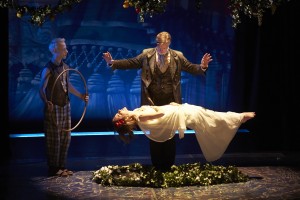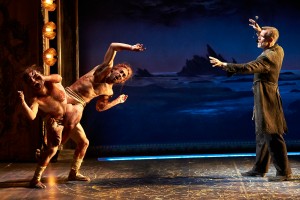 A confession: I’ve never been a fan of Magic. Who wants to be tricked? Where is the pleasure in being deceived, confused, confounded?
A confession: I’ve never been a fan of Magic. Who wants to be tricked? Where is the pleasure in being deceived, confused, confounded?
Maybe I’m too gullible. And maybe I resent being made to feel like one of those suckers-born-every-minute that P.T. Barnum gloated about.
And maybe, frankly, I’m not all that eager to give up my gullibility.
It’s somehow a part of my Willing Suspension of Disbelief, that invaluable trick of the imagination that enables us to walk into a theater and “believe” what we see is “true.” Magic doesn’t fit into that equation somehow; doesn’t quite play by the same sandbox rules. No one is gullible enough to believe certain illusions are real.
And now another confession: After seeing “The Tempest” at South Coast Repertory, I am a changed man and all is forgiven.
The show is fraught with illusions from beginning to end — some of them terrifying, some of them hilarious, some of them terrifying AND hilarious, all of them breathtakingly beautiful, and all of them utterly in service to Shakespeare’s play.
It’s that last part that is so crucial to the integrity and success of this production. The magical effects (designed by the brilliant Teller of Penn and Teller) are so organic they could almost be a collaboration with Shakespeare himself.
The Tempest is, among other things, a play about magic. Our protagonist Prospero, sent off to die in an unseaworthy vessel by his conniving brother, is, in fact, a magician. The island where he lands with his baby daughter Miranda is an enchanted place. With the aid of the sprite Ariel, Prospero can even create a tempest to purposefully shipwreck on the same island twelve years later said wicked brother and his entourage.
daughter Miranda is an enchanted place. With the aid of the sprite Ariel, Prospero can even create a tempest to purposefully shipwreck on the same island twelve years later said wicked brother and his entourage.
Whereupon Prospero employs magic for revenge, for protection against their further conniving, and in the case of his beloved daughter, matchmaking with the shipwrecked young Ferdinand.
The magic written into Shakespeare’s play is, of course, a metaphor for the power of the theater itself; of storytelling, of the “magic” inherent in the craftsmanship of all theater makers’ art. (Or should that be artlessness?)
“The Tempest” is Shakespeare’s final play, and it’s widely believed Prospero is the voice of the playwright himself when he, at the end, renounces his magic (his “revels ended”) so that his newly married daughter may live a normal life on the mainland.
It’s a beautiful and poignant gesture, as though Shakespeare were saying: I leave this pursuit (the theater) to other, younger, practitioners, and step aside.

It is difficult to imagine a better conceived, brilliantly collaborative production of “The Tempest” than this. A co-production of SCR, American Repertory Theatre at Harvard, and Smith Center in Las Vegas, the show, years in the making, has already played those earlier venues, and it benefits now from a well-earned ease.
The uniformly sterling cast has full ownership of Shakespeare’s text and shares it with confident generosity. Every well-spoken moment is clear as rainwater.
Director Aaron Posner enlisted what at first glance would seem a motley crew: magic designer Teller, composers Tom Waits and Kathleen Brennen, choreographer Matt Kent of the edgy group Pilobolus, set designer Daniel Conway, and costume designer Paloma Young.
Perhaps Posner’s personal magic power is getting disparate, and gigantic, talents on the same page. He succeeds, triumphantly.
The play is an explosion of theatrical inspiration — a glorious celebration of the play, Shakespeare himself, the very notion of artistic collaboration toward making something luminous, new, unique and greater than the sum of its parts.
Now that is the magic of theater.
“The Tempest” runs through Sept. 28. Call (714) 708-5555 or visit SCR.org.




